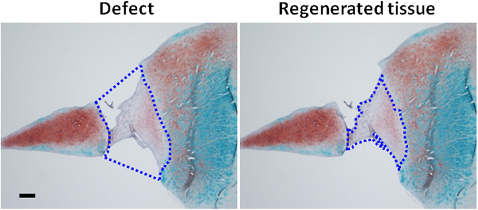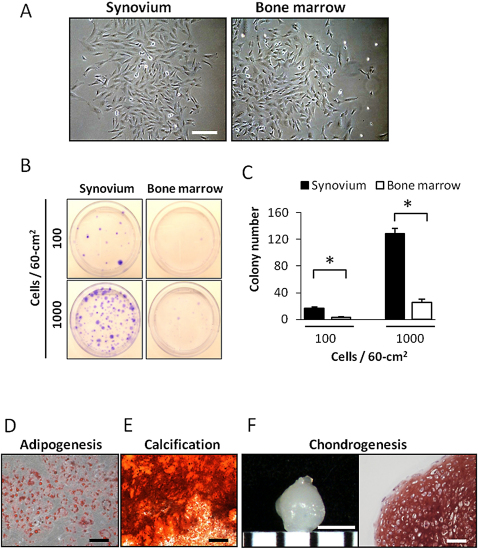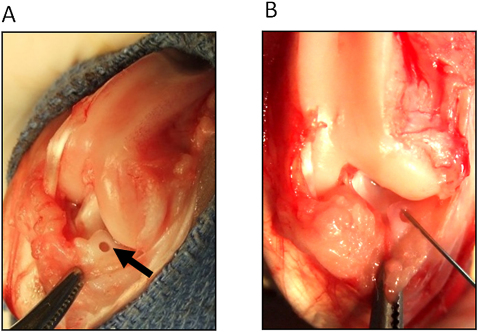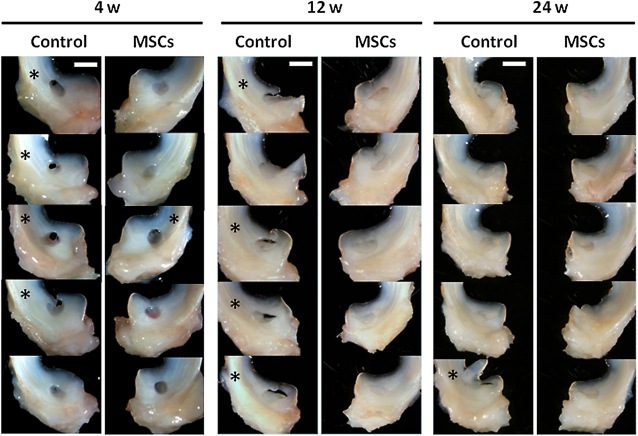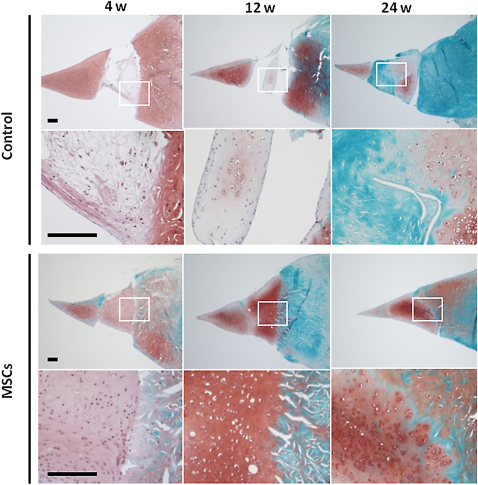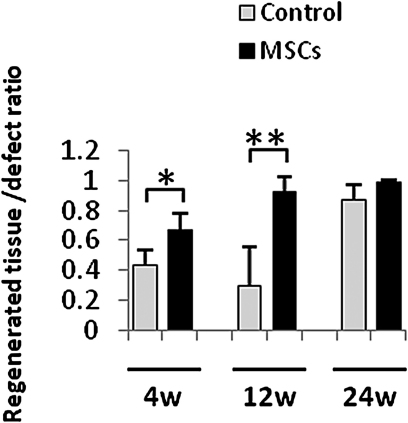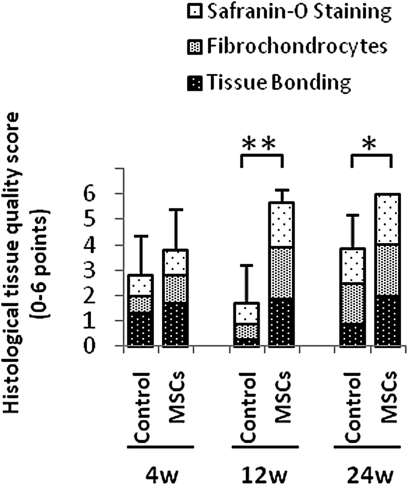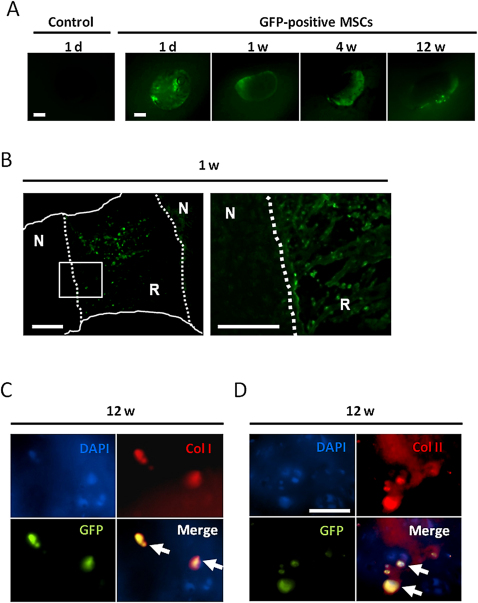Update
This article was updated on May 16, 2012, because of a previous error. The legend for Figures 7-A and 7-B that had previously read “Representative macroscopic appearance (Fig. 7-A) and histological sections (Fig. 7-B) of the meniscal defect one day to twelve weeks after the implantation of GFP-positive green fluorescent protein under fluorescence” now reads “Representative macroscopic appearance (Fig. 7-A) and histological sections (Fig. 7-B) of the meniscal defect one day to twelve weeks after the implantation of GFP-positive synovial mesenchymal stem cells under fluorescence.”
Background:
Indications for surgical meniscal repair are limited, and failure rates remain high. Thus, new ways to augment repair and stimulate meniscal regeneration are needed. Mesenchymal stem cells are multipotent cells present in mature individuals and accessible from peripheral connective tissue sites, including synovium. The purpose of this study was to quantitatively evaluate the effect of implantation of synovial tissue-derived mesenchymal stem cells on meniscal regeneration in a rabbit model of partial meniscectomy.
Methods:
Synovial mesenchymal stem cells were harvested from the knee of one New Zealand White rabbit, expanded in culture, and labeled with a fluorescent marker. A reproducible 1.5-mm cylindrical defect was created in the avascular portion of the anterior horn of the medial meniscus bilaterally in fifteen additional rabbits. Allogenic synovial mesenchymal stem cells suspended in phosphate-buffered saline solution were implanted into the right knees, and phosphate-buffered saline solution alone was placed in the left knees. Meniscal regeneration was evaluated histologically at four, twelve, and twenty-four weeks for (1) quantity and (2) quality (with use of an established three-component scoring system). A similar procedure was performed in four additional rabbits with use of green fluorescent protein-positive synovial mesenchymal stem cells for the purpose of tracking progeny following implantation.
Results:
The quantity of regenerated tissue in the group that had implantation of synovial mesenchymal stem cells was greater at all end points, reaching significance at four and twelve weeks (p < 0.05). Tissue quality scores were also superior in knees treated with mesenchymal stem cells compared with controls at all end points, achieving significance at twelve and twenty-four weeks (3.8 versus 2.8 at four weeks [p = 0.29], 5.7 versus 1.7 at twelve weeks [p = 0.008], and 6.0 versus 3.9 at twenty-four weeks [p = 0.021]). Implanted cells adhered to meniscal defects and were observed in the regenerated tissue, where they differentiated into type-I and II collagen-expressing cells, at up to twenty-four weeks.
Conclusions:
Synovial mesenchymal stem cells adhere to sites of meniscal injury, differentiate into cells resembling meniscal fibrochondrocytes, and enhance both quality and quantity of meniscal regeneration.
Clinical Relevance:
These results may stimulate further exploration into the utility of synovial mesenchymal stem cells in the treatment of meniscal injury in large animals and humans.
The meniscus is a fibrocartilage structure functioning to increase surface contact area, absorb mechanical loads, and improve stability across the knee joint. Following injury, the human meniscus demonstrates poor healing potential because of the largely avascular nature of its fibrocartilaginous tissue. Failure rates after attempted surgical repair remain high, ranging from 24% to 50% for isolated meniscal tears1-8. As a result, partial meniscectomy is often the treatment of choice. Unfortunately, removal of this important shock absorber leads to accelerated osteoarthritis9-12. Thus, new techniques designed to restore meniscal structure and function following injury are needed.
Mesenchymal stem cells are multipotent cells present in mature individuals and readily accessible from peripheral connective tissue sites such as bone marrow13,14, periosteum15, adipose16, and the synovial lining of major joints17. These cells, which are capable of differentiating into osteoblasts, chondrocytes, adipocytes, and myocytes, represent an attractive potential means of regenerating damaged connective tissues including intra-articular structures of the knee, such as the meniscus18-20.
Recent literature has suggested that synovial tissue-derived mesenchymal stem cells may have the potential to aid in healing and regeneration of cartilage injuries, such as those involving the meniscus18,20-24. Synovial mesenchymal stem cells represent an attractive cell source because they can be harvested in a minimally invasive manner from synovial tissue and are easily expanded in culture18,20-22. In addition, multiple investigators have found that synovial mesenchymal stem cells possess a particularly high capacity for chondrogenic differentiation and proliferation compared with mesenchymal stem cells obtained from other tissues, such as bone marrow or periosteum18,20,22.
Synovial mesenchymal stem cells are also capable of adhering to damaged intra-articular structures such as the meniscus and participating in the repair process in rat models23-26. In rats, however, the animals’ innate regenerative capacity limits the ability of the investigator to compare the effect of the cells on tissue regeneration in experimental versus control groups24. In contrast to smaller rodents, the limited inherent regenerative capacity of the rabbit meniscus makes the rabbit a more favorable animal model in which to evaluate meniscal regeneration techniques. Moon et al. found that, following medial meniscectomy, the rabbit meniscus only partially regenerated with primarily fibrous tissue27. More recently, rabbit models have been used to study the effects of a variety of surgical interventions aimed at regenerating more normal meniscal tissue with use of scaffolds composed of collagen, polyglycolic acid, or gelatin with or without a potential biological regenerative stimulus28-30.
The purpose of this study was to evaluate the effect of synovial mesenchymal stem cell supplementation on meniscal regeneration in a rabbit model of partial meniscectomy.
Materials and Methods
Animals
The experimental protocols were approved by the Scott & White Institutional Animal Care and Use Committee and Texas A&M University Institutional Biosafety Committee. Two mature New Zealand White rabbits were used as cell donors for two experimental groups as follows: a single mature wild-type rabbit served as the synovial donor for Group A (fifteen rabbits), and a single transgenic rabbit bred to ubiquitously express green fluorescent protein (GFP; Kitayama Labes, Nagano, Japan)31,32 served as the synovial donor for Group B (four rabbits).
Tissue Harvesting and Mesenchymal Stem Cell Preparation
Through a medial parapatellar surgical approach, the right knee of one mature wild-type New Zealand White rabbit was accessed and synovium from the medial, lateral, and suprapatellar regions of the joint was resected. Bone marrow was harvested from the femoral intramedullary canal for comparison of the proliferation capacity of synovial and bone-marrow mesenchymal stem cells.
Isolated cells were cultured for three passages, and a fluorescent lipophilic tracer, CM-DiI (chloromethylbenzamido DiI; Invitrogen, Carlsbad, California), was added to the cultured synovial tissue-derived cells (see Appendix). These CM-DiI-labeled cells were then used for implantation in experimental knees of Group-A rabbits to evaluate the effect of synovial mesenchymal stem cell supplementation on the quality and quantity of meniscal regeneration, as detailed below in the section on meniscectomy and cell implantation.
A separate subset of the experiment was performed with use of GFP-positive synovial tissue-derived cells obtained from the knee synovium of a transgenic New Zealand White rabbit bred to ubiquitously express GFP (Kitayama Labes)31,32. These cells were processed as described above without the addition of CM-DiI. These GFP-positive synovial tissue-derived cells were implanted in the experimental knees of Group-B rabbits to track not only implanted cells but also their progeny, as detailed below in the section on meniscectomy and cell implantation.
Colony-Forming Assay
To compare proliferation potentials, synovial tissue-derived cells and bone marrow-derived cells from passage 3 were plated in 60-cm2 dishes at densities of 100 or 1000 cells per dish, cultured in complete medium for fourteen days, and stained with 0.5% crystal violet in methanol for five minutes. The number of colonies was then counted. Colonies that were <2 mm in diameter and colonies that were faintly stained were ignored.
In Vitro Differentiation Assay
Isolated synovial tissue-derived cells were cultured under conditions conducive to adipogenesis, calcification, and chondrogenesis to assess for multipotentiality (see Appendix).
Meniscectomy and Implantation of Synovial Mesenchymal Stem Cells
Nineteen additional mature New Zealand White rabbits were divided into two groups, consisting of fifteen rabbits in Group A and four in Group B.
Group A
With the animal under general anesthesia, each knee was approached through a medial parapatellar arthrotomy, maximally flexed, and a reproducible 1.5-mm-diameter full-thickness cylindrical defect was produced in the avascular inner two-thirds33 of the anterior portion of the medial meniscus with use of a biopsy punch (Miltex, York, Pennsylvania).
With the tibial joint surface facing upward, 2 × 106 CM-DiI-labeled synovial tissue-derived mesenchymal stem cells in 50 μL of phosphate-buffered saline solution (PBS)34 were placed directly into the meniscal defect in each of the right knees with use of a 27-gauge needle. Knees were then held stationary for ten minutes during wound closure. In left knees, the same volume of plain PBS was implanted as a control, and the knees were once again held stationary for ten minutes.
Capsule and skin were closed in layers with absorbable suture. Rabbits were allowed to move freely in their cages. Medial menisci from both knees were harvested at four, twelve, and twenty-four-week end points.
Group B
A similar procedure was performed on the remaining four rabbits, with the goal of tracking the fate of implanted mesenchymal stem cells and their progeny. For this purpose GFP-positive synovial mesenchymal stem cells were implanted in the right knees in the same manner as those in Group A. The same volume of PBS was placed in the left knees once again. Medial menisci from the right and left knees were then harvested at one-day, one-week, four-week, and twelve-week end points.
Histological Analysis
Meniscal specimens from Group A were fixed in 4% paraformaldehyde, decalcified, and embedded in paraffin. Specimens were then sectioned into slices 5 μm thick in the radial plane. The quantity and quality of regenerated meniscal tissue were then evaluated as follows:
Tissue Quantity Analysis
The quantity of tissue regeneration was evaluated with use of random tissue sections obtained from the central portion of the meniscal defect as shown in Figure 1 and described in detail in the Appendix. The area of the original defect (D) and the area occupied by regenerated tissue inside the defect (R) were calculated with use of Photoshop CS3 software (Adobe Systems, San Jose, California).Tissue regeneration is expressed as the ratio of regenerated tissue area to the entire defect area (regeneration ratio = R/D).
Fig. 1.
Method of calculating the quantity of tissue regeneration. The area of the entire defect (D; blue dotted line; left) and the regenerated tissue (R; blue dotted line; right) were calculated. The regenerated tissue-to-defect ratio (R/D) was used to quantify the amount of regenerated meniscal tissue. The ideal quantity of regeneration would result in a value of 1, and incomplete regeneration would result in a value of <1. Scale bar represents 200 μm.
Tissue Quality Scoring Analysis
A quantitative scoring system evaluating three dimensions of meniscal regeneration was used (see Appendix)30. Sections to be scored were stained with safranin O. Histological scoring was performed by two investigators blinded to treatment category.
Fluorescent Microscopy
Photographs of the gross and microscopic appearance of each Group-A meniscal specimen were made under fluorescence to demonstrate the presence or absence, as well as relative density, of CM-DiI-labeled synovial mesenchymal stem cells within the defects and surrounding intact meniscal tissue.
To determine the fate of the implanted GFP-positive synovial mesenchymal stem cells and their progeny in Group-B rabbits, menisci from both knees were harvested, fixed in 4% paraformaldehyde, and transferred to 20% sucrose solution. Specimens were flash-frozen, cut in a cryostat, and observed under fluorescent microscopy.
Immunohistochemistry for Type-I and Type-II Collagen
Frozen sections from the menisci of Group-B rabbits were also used to detect type-I and type-II collagen synthesis with use of standard immunohistochemistry techniques (see Appendix). Background nuclei were counterstained with 4′, 6-diamidino-2-phenylindole dihydrochloride (DAPI).
Statistical Methods
An a priori power calculation was performed with use of mean and standard deviation assumptions based on previously published data30. A sample size of five rabbits was found to be sufficient to detect a difference of 3 points in the tissue quality score at the twelve-week end point, with a power of 89% at a significance level of 0.05. The Mann-Whitney U test was used to compare synovial mesenchymal stem cells and control groups at each period. P values of <0.05 were considered significant.
Source of Funding
Funding for this study was provided by an internal institutional grant from the Scott & White Research Grants Program as well as a grant from the National Institutes of Health (NIH/NCRR grant P40 RR 17447).
Results
Synovial Mesenchymal Stem Cells Have High Proliferation Capacity and Multipotentiality
Abundant multipotent cells were isolated from the synovial tissue of the initial donor rabbit. Isolates produced spindle-shaped cells that adhered to plastic culture dishes under standard conditions, and appeared morphologically similar to the cultured bone-marrow mesenchymal stem cells (Fig. 2-A). While both synovial and bone-marrow mesenchymal stem cells were capable of forming single-cell colonies, the synovial mesenchymal stem cells demonstrated greater colony-forming potential when plated at densities of 100 cells per 60 cm2 and 1000 cells per 60 cm2 (Figs. 2-B and 2-C).
Fig. 2.
Figs. 2-A through 2-F Synovial mesenchymal stem cells have high proliferation capacity and multipotentiality. Synovium refers to synovial mesenchymal stem cells, and bone marrow refers to bone-marrow mesenchymal stem cells. Fig. 2-A Histological appearance of synovial mesenchymal stem cells (left) and bone-marrow mesenchymal stem cells (right) at passage 3. Both groups formed monolayers of spindle-shaped cells that adhered to plastic culture dishes. Scale bar indicates 200 μm. Fig. 2-B Colony formation of synovial mesenchymal stem cells and bone-marrow mesenchymal stem cells at passage 3. Nucleated cells from synovium and bone marrow were plated at 100 and 1000 cells per 60-cm2 dish and cultured for fourteen days (n = 5 cultures each). Culture dishes stained with crystal violet are shown. Fig. 2-C Graph showing the number of colonies (>2 mm) per dish at 100 or 1000 cells per 60 cm2. *P < 0.01. Fig. 2-D Adipogenesis. Adipocyte colonies were stained with oil red O. Scale bar represents 200 μm. Fig. 2-E Calcification. Calcified colonies were stained with alizarin red. Scale bar represents 500 μm. Fig. 2-F Chondrogenesis. Gross photograph of a pellet (left). Scale bar represents 1 mm. Histological section of the pellet stained with safranin O (right). Scale bar represents 100 μm.
Isolated synovial mesenchymal stem cells were capable of differentiation into adipocytes and chondrocytes, and were calcified under the proper conditions (Figs. 2-D, 2-E, and 2-F). In adipogenic medium, colonies stained well with oil red O (Fig. 2-D). In calcification medium, colonies produced abundant calcium (Fig. 2-E). In chondrogenic medium, smooth glistening pellets, which stained diffusely with safranin O, were produced (Fig. 2-F). Thus, the isolated synovial mesenchymal stem cells met the requirements for multipotent mesenchymal stromal cells as set forth by Dominici et al.35.
Locally Implanted Synovial Mesenchymal Stem Cells Promote Meniscal Regeneration
A representative photograph of the in vivo 1.5-mm-diameter full-thickness meniscal biopsy of the avascular portion of the anterior horn of the medial meniscus is shown in Figure 3-A. Application of either synovial mesenchymal stem cells suspended in PBS (right knees) or PBS alone (left knees) is demonstrated in Figure 3-B.
Fig. 3.
Figs. 3-A and 3-B Meniscal biopsy and implantation of synovial mesenchymal stem cells. Fig. 3-A Intraoperative photograph made following meniscal biopsy. A 1.5-mm-diameter full-thickness cylindrical defect (arrow) was produced in the inner two-thirds of the anterior horn of the medial meniscus. Fig. 3-B Intraoperative photograph demonstrating implantation of the synovial mesenchymal stem cells. Two million synovial mesenchymal stem cells in 50 μL of phosphate-buffered saline solution were placed directly into the meniscal defect of experimental knees with use of a 27-gauge needle. In control knees, the same volume of plain phosphate-buffered saline solution was used.
A gross representation of regenerated meniscal tissue within the 1.5-mm cylindrical defects is shown in Figure 4. In the control knees, grossly visible, full-thickness defects remained in four of five specimens at four and twelve weeks (asterisks in Figure 4). In knees supplemented with synovial mesenchymal stem cells, however, such defects remained in only one specimen at four weeks and none at twelve weeks. The macroscopic difference between mesenchymal stem cell and control groups is less dramatic at twenty-four weeks, by which time four of five defects in control knees and five of five defects in knees supplemented with mesenchymal stem cells were completely covered with at least partial-thickness tissue on gross inspection.
Fig. 4.
Synovial mesenchymal stem cells (MSCs) promote meniscal regeneration (macroscopic observation). Macroscopic findings of the meniscus at four, twelve, and twenty-four weeks after the implantation of synovial mesenchymal stem cells. The specimens in which full-thickness grossly visible defects remained are denoted by an asterisk. Scale bar represents 2 mm.
Representative sections of regenerated meniscus stained with safranin O at four, twelve, and twenty-four weeks after implantation of synovial mesenchymal stem cells, as well as sections of normal meniscus stained with safranin O, are shown in Figures 5-A and 5-B. The quantity of regenerated meniscal tissue was greater when measured histologically in knees receiving synovial mesenchymal stem cells, reaching significance at four and twelve weeks (p < 0.05) (Fig. 5-C, Table I). By twelve weeks, an average of >90% of the cylindrical defect had filled in with regenerated tissue in knees supplemented with synovial mesenchymal stem cells compared with <30% in controls.
Synovial mesenchymal stem cells (MSCs) promote the meniscal regeneration (histological observation).
Fig. 5-A.
Low and high-power images of representative sections of regenerated meniscus stained with safranin O at four, twelve, and twenty-four weeks after implantation of synovial mesenchymal stem cells. The inset shows the area seen at higher magnification in the photomicrograph below. Scale bars represent 200 μm.
Fig. 5-B.
Low and high-power representative images of the normal meniscus stained with safranin O. Scale bars represent 200 μm.
Fig. 5-C.
Regenerated tissue-to-defect ratios are displayed as the mean and the standard deviation for synovial mesenchymal stem cell (MSCs) and control groups at each end point. *The difference between the groups was significant (p < 0.05). **The difference between the groups was significant (p < 0.01).
Fig. 5-D.
Results of the histological scoring system for regenerated meniscus. The scores are displayed as the mean and the standard deviation. *The difference between the groups was significant (p < 0.05). **The difference between the groups was significant (p < 0.01).
TABLE I.
Regenerated Tissue-to-Defect Ratio
| Ratio* | P Value | |
| 4 weeks | ||
| Control | 0.44 ± 0.10 | 0.028† |
| MSC | 0.67 ± 0.11 | |
| 12 weeks | ||
| Control | 0.29 ± 0.27 | 0.009‡ |
| MSC | 0.93 ± 0.10 | |
| 24 weeks | ||
| Control | 0.87 ± 0.10 | 0.077 |
| MSC | 0.98 ± 0.03 | |
Regenerated tissue-to-defect ratios (range, 0 to 1) are given as the mean (and standard deviation) for synovial mesenchymal stem cell (MSC) and control groups at each end point.
The difference between the groups was significant (p < 0.05).
The difference between the groups was significant (p < 0.01).
The quality of meniscal regeneration was also superior in knees supplemented with synovial mesenchymal stem cells at all end points, achieving significance at twelve and twenty-four weeks (Fig. 5-D, Table II). By twenty-four weeks, all menisci from knees treated with synovial mesenchymal stem cells scored the highest possible score in each of the three quality domains measured—staining with safranin O, existence of fibrochondrocytes, and extent of bonding between regenerated tissue and the borders of the meniscal defect.
TABLE II.
Histological Tissue Quality Score
| Score* | P Value | |
| 4 weeks | ||
| Control | 2.8 ± 1.5 | 0.29 |
| MSC | 3.8 ± 1.6 | |
| 12 weeks | ||
| Control | 1.7 ± 1.5 | 0.008† |
| MSC | 5.7 ± 0.4 | |
| 24 weeks | ||
| Control | 3.9 ± 1.3 | 0.021‡ |
| MSC | 6.0 ± 0 | |
Results of histological scoring system (range, 0 to 6) for regenerated meniscus. The values are given as the mean and the standard deviation.
The difference between the mesenchymal stem cell (MSC) and control groups was significant (p < 0.01).
The difference between the groups was significant (p < 0.05).
Synovial Mesenchymal Stem Cells Adhere to Sites of Meniscal Injury and Differentiate into Type-I and II Collagen-Producing Cells
Gross and histologic fluorescence imaging revealed the presence of CM-DiI-labeled cells in high concentration within the meniscal defects of Group-A rabbits at four, twelve, and twenty-four weeks following implantation (Figs. 6-A and 6-B). Although the number of CM-DiI-labeled cells decreased with time, a small number of CM-DiI-labeled cells were observed in the regenerated tissue even at twenty-four weeks. Significant fluorescence was not detected elsewhere in the meniscus, suggesting that implanted mesenchymal stem cells preferentially adhered to the site of meniscal injury. No CM-DiI-labeled cells were detected by fluorescence in control specimens.
Fig. 6.
Figs. 6-A and 6-B CM-DiI-labeled synovial mesenchymal stem cells (MSCs) adhere to sites of meniscal injury and remain at twenty-four weeks. Representative macroscopic appearance (Fig. 6-A) and histological sections (Fig. 6-B) of the meniscal defect after implantation of CM-DiI-labeled synovial mesenchymal stem cells under bright light (top) and fluorescence (bottom). In the histological sections (Fig. 6-B), the white solid line indicates the outer edge of the meniscus, and the white dotted line indicates the border between native meniscus and regenerated tissue. Scale bar represents 400 μm.
In Group-B rabbits, GFP-positive synovial mesenchymal stem cells were found within the meniscal defect as early as one day after injury and remained in high concentrations as late as twelve weeks after injury (Figs. 7-A and 7-B). No GFP-positive cells were detected in the contralateral, control menisci, thus supporting the assumption that neither synovial mesenchymal stem cells implanted in the experimental knee nor their progeny directly affect regeneration at the distant injury site in the contralateral knee.
Fig. 7.
Figs. 7-A and 7-B Green fluorescent protein (GFP)-positive synovial mesenchymal stem cells (MSCs) adhere to sites of meniscal injury in experimental knees, where they produce type-I and type-II collagen. Representative macroscopic appearance (Fig. 7-A) and histological sections (Fig. 7-B) of the meniscal defect one day to twelve weeks after the implantation of GFP-positive synovial mesenchymal stem cells under fluorescence. In the histological sections (Fig. 7-B), the white solid line indicates the outer edge of the meniscus. The white dotted line indicates the border between native meniscus (N) and regenerated tissue (R). The inset shows the area seen at higher magnification in the photomicrograph on the right. The scale bars represent 200 μm. Figs. 7-C and 7-D Fluorescent images of the regenerated meniscus at twelve weeks after implantation of GFP-positive synovial mesenchymal stem cells. The sections were immunostained with anti-type-I collagen (Fig. 7-C) and anti-type-II collagen (Fig. 7-D). Nuclei were counterstained with DAPI (4′, 6-diamidino-2-phenylindole dihydrochloride; blue) to demonstrate the cellular background (GFP-positive cells as well as cells not expressing GFP). GFP-positive cells are shown in green (bottom left), and type-I collagen-producing cells (Fig. 7-C) and type-II collagen-producing cells (Fig. 7-D) are shown in red (top right). Arrows in merge (bottom right) indicate double-positive cells of GFP and type-I collagen (Fig. 7-C) or type-II collagen (Fig. 7-D). Scale bar represents 25 μm. Col I = type-I collagen, and Col II = type-II collagen.
The number of GFP-positive cells within the defect decreased with time from one day to twelve weeks. Even at twelve weeks, however, a population of GFP-positive cells remained in the regenerated tissue and expressed both type-I collagen (Fig. 7-C) and type-II collagen (Fig. 7-D), possibly aiding in the regenerative process.
Discussion
It has been hypothesized for over thirty years that a factor within synovium may enhance meniscal regeneration and healing, but the underlying mechanism remains unclear. Kim and Moon were among the first to document this association when, in 1979, they showed that meniscectomized rabbit knees subjected to complete synovectomy failed to regenerate meniscal tissue to the same extent as knees with intact synovium36. More recently, investigators have demonstrated improved healing rates in meniscal tears supplemented with synovial flaps or grafts in animal models37,38 and synovial rasping in human clinical studies39,40.
The discovery of mesenchymal stem cells in mature synovial tissue with exceptional potential for proliferation and chondrogenic differentiation suggests that these cells may be the source of regenerative stimulus within synovium17,18,20,22. The results of this study provide more convincing evidence that synovial mesenchymal stem cells are capable of stimulating meniscal repair and regeneration.
While the quantity of regenerated tissue was significantly greater in knees supplemented with synovial mesenchymal stem cells at four and twelve-week end points, the defects filled relatively well with tissue by twenty-four weeks in control knees. This may be seen as a shortcoming of the experimental model; however, one must consider not only quantity but also quality of the regenerated tissue. Significantly inferior tissue-quality scores seen in control knees at the twenty-four-week end point suggest that these defects ultimately filled with hypocellular, poorly bonded, fibrous scar tissue as opposed to meniscal fibrocartilage. In contrast, meniscal defects treated with synovial mesenchymal stem cells regenerated with well-bonded tissue closely resembling normal meniscus in cellularity and matrix composition. The results seen in control knees at twenty-four weeks may be analogous to filling of articular cartilage defects with fibrous tissue, as opposed to true regeneration with hyaline cartilage, after failed articular cartilage restoration procedures41.
Implanted mesenchymal stem cells found within the meniscal defects resemble native meniscal fibrochondrocytes not only in histological appearance but also in the types of collagen they produce. Meniscal fibrochondrocytes, articular chondrocytes, and fibroblasts, as well as the matrices these cells synthesize, can be distinguished by collagen typing42. The primary collagen in meniscal fibrocartilage is type-I collagen, but a substantial amount of type-II collagen is present as well42,43. In contrast, hyaline cartilage is composed of primarily type-II collagen, and fibrous scar tissue is composed of largely type-I collagen42,44. The implanted synovial mesenchymal stem cells in this experiment produced both type-I collagen and type-II collagen, suggesting differentiation into fibrochondrocytes and synthesis of a fibrocartilage matrix.
Much of the recent work surrounding meniscal regeneration has focused on the use of an active biological component added to a tissue scaffold or carrier compound, which functions to contain the biological component within the injured area30-32,45. In contrast to prior studies, the improvements in meniscal regeneration in the current model were achieved without the use of additives designed to contain the implanted cells within the defect. Both fluorescently (CM-DiI) labeled and GFP-positive synovial mesenchymal stem cells preferentially adhered to meniscal defects, where they remained for up to twenty-four weeks. On the basis of the work by Koga et al., this adhesion appears to occur via local surface adhesion molecules, including ICAM-1 (intercellular adhesion molecule-1) and VCAM-1 (vascular cell adhesion molecule-1)46. In addition, the attachment takes place rapidly, with >60% of synovial mesenchymal stem cells adhering to injured cartilage within ten minutes of application in an ex vivo human cartilage defect model46. Thus, the cells themselves seem to have the inherent ability to quickly adhere to the defect and facilitate the regenerative process.
In an effort to determine the optimal source of mesenchymal stem cells for purposes of intra-articular regeneration, prior studies have compared the in vivo regenerative potential of mesenchymal stem cells obtained from a variety of tissue sources23,34. Koga et al. found that mesenchymal stem cells derived from bone marrow and synovium have greater in vivo chondrogenic regenerative potential than mesenchymal stem cells derived from adipose and muscle34. The chondrogenic and meniscal regenerative potential of mesenchymal stem cells obtained from synovium and bone marrow, however, appears to be more similar23,34. Our rationale for selecting synovial mesenchymal stem cells was based largely on in vitro evidence of superior capacity of synovial mesenchymal stem cells for rapid proliferation and synthesis of chondrogenic matrix in rat20, rabbit34, and human studies18. The current experiment confirmed the superior in vitro proliferation capacity of rabbit synovial mesenchymal stem cells compared with rabbit bone marrow-derived mesenchymal stem cells. This experiment did not, however, directly compare the regenerative potential of synovial mesenchymal stem cells and bone marrow-derived mesenchymal stem cells or other additional cell types in vivo.
Other approaches for addressing meniscal deficiency and irreparable meniscal tears in humans are under investigation, but an ideal solution has yet to be discovered. Meniscal allograft transplantation, first described in 1989 by Milachowski et al.47, has shown promising results in select patients48, but is complicated by concerns regarding processing and storage49, subclinical host immune response50, and a low tolerance for graft-recipient size mismatch51. The collagen meniscal implant (Collagen Meniscus Implant; ReGen Biologics, Hackensack, New Jersey), a tissue-engineered biologic scaffold fabricated from bovine type-I collagen, has also demonstrated encouraging results compared with partial meniscectomy45; however, defect filling is incomplete at second-look arthroscopy45 and concerns exist regarding the risk of immune reaction to bovine collagen52.
Furthermore, the above treatment options are designed to treat complete or partial meniscal defects, but neither provides a means to stimulate healing of avascular zone tears. In vitro meniscal tissue-culture experiments offer evidence that proregenerative cytokines such as transforming growth factor-β (TGF-β), insulin-like growth factor-1 (IGF-1), platelet-derived growth factor (PDGF), and vascular endothelial growth factor (VEGF) may potentially provide such a healing stimulus by increasing meniscal cell proliferation and collagen synthesis53,54. In vivo evidence in support of the efficacy of these growth factors in meniscal healing is currently lacking, however. For example, the addition of VEGF coating to meniscal suture failed to increase angiogenesis or improve healing compared with conventional suture in avascular meniscal tears in sheep55.
In the present study, we chose to evaluate the regenerative potential of synovial mesenchymal stem cells without scaffolds or additional growth factors. The ability of synovial mesenchymal stem cells to adhere independently to the site of meniscal injury, differentiate into fibrochondrocytes, and synthesize a new matrix that closely resembles native meniscal fibrocartilage without a scaffold or extrinsic cytokines seems to negate the need for such additional stimulus. In addition, this approach avoids the potential for complications associated with disease transmission and immune reaction and, in this model, results in virtually complete regeneration of the meniscal defect. It is possible, however, that meniscal regeneration stimulated by supplementation with synovial mesenchymal stem cells may be further enhanced by the addition of a tissue scaffold when used for large meniscal defects in subjects with little inherent regenerative capacity.
Limitations of this study include those that are inherent to the animal model and those that result from the experimental design. Although the capacity for meniscal regeneration is lower in rabbits than rats, it is likely greater than that in humans27,33. In light of this, caution is encouraged when extrapolating the results of this study to humans.
With regard to the experimental design, the results of this study portray a simplified picture of the events occurring at a molecular level, as the present study did not evaluate the influence of synovial mesenchymal stem cells on the production or local concentration of proregenerative cytokines such as TGF-β, IGF-1, or PDGF, which promote proteoglycan synthesis and increase cellularity within the meniscus53,54. It is likely that the regenerative process involves a complex interplay between the intact meniscus adjacent to the defect, the implanted synovial mesenchymal stem cells, and alterations in local cytokine concentrations, and this was not fully elucidated in the present study. Finally, although the degree of tissue bonding was considered as a component of the tissue quality score, this experiment did not include a precise quantitative evaluation of the integration between regenerated and native meniscal tissue. Nor did it evaluate the biomechanical characteristics of the regenerated tissue, which are critical to meniscal function. Such an evaluation would be more appropriate in a model with a discrete linear tear or larger meniscal defect.
In conclusion, synovial mesenchymal stem cells implanted into the rabbit knee are capable of adhering to sites of meniscal injury, differentiating into type-I and type-II collagen-producing cells with appearance similar to native meniscal fibrochondrocytes, and enhancing both the quality and quantity of regenerated meniscal tissue. In addition to providing a potential explanation for the association between synovial stimulation and meniscal healing, these results may generate further stimulus for exploring the utility of synovial mesenchymal stem cells in the treatment of meniscal injury in large animal models or humans, with potential applications ranging from supplementing suture repair of avascular zone meniscal tears, to stimulating regeneration of large meniscal defects.
Supplementary Material
A table showing the histological tissue quality scoring system and an expanded Materials and Methods section describing the tissue harvesting and mesenchymal stem cell preparation, in vitro differentiation assays, and tissue quality analysis
Acknowledgments
Note: The authors thank Dina Gaupp, Center for Gene Therapy, Tulane Health Sciences Center, for assistance with histological sectioning.
Footnotes
Disclosure: One or more of the authors received payments or services, either directly or indirectly (i.e., via his or her institution), from a third party in support of an aspect of this work. In addition, one or more of the authors, or his or her institution, has had a financial relationship, in the thirty-six months prior to submission of this work, with an entity in the biomedical arena that could be perceived to influence or have the potential to influence what is written in this work. No author has had any other relationships, or has engaged in any other activities, that could be perceived to influence or have the potential to influence what is written in this work. The complete Disclosures of Potential Conflicts of Interest submitted by authors are always provided with the online version of the article.
References
- 1.Fu FH, Harner CD, Vince KG, editors. Knee surgery. Baltimore: Williams & Wilkins; 1994
- 2.Albrecht-Olsen PM, Bak K. Arthroscopic repair of the bucket-handle meniscus. 10 failures in 27 stable knees followed for 3 years. Acta Orthop Scand. 1993;64:446-8 [DOI] [PubMed] [Google Scholar]
- 3.Cannon WD, Jr, Vittori JM. The incidence of healing in arthroscopic meniscal repairs in anterior cruciate ligament-reconstructed knees versus stable knees. Am J Sports Med. 1992;20:176-81 [DOI] [PubMed] [Google Scholar]
- 4.Tenuta JJ, Arciero RA. Arthroscopic evaluation of meniscal repairs. Factors that effect healing. Am J Sports Med. 1994;22:797-802 [DOI] [PubMed] [Google Scholar]
- 5.Johnson MJ, Lucas GL, Dusek JK, Henning CE. Isolated arthroscopic meniscal repair: a long-term outcome study (more than 10 years). Am J Sports Med. 1999;27:44-9 [DOI] [PubMed] [Google Scholar]
- 6.Majewski M, Stoll R, Widmer H, Müller W, Friederich NF. Midterm and long-term results after arthroscopic suture repair of isolated, longitudinal, vertical meniscal tears in stable knees. Am J Sports Med. 2006;34:1072-6 Epub 2006 Feb 1 [DOI] [PubMed] [Google Scholar]
- 7.Venkatachalam S, Godsiff SP, Harding ML. Review of the clinical results of arthroscopic meniscal repair. Knee. 2001;8:129-33 [DOI] [PubMed] [Google Scholar]
- 8.Stärke C, Kopf S, Petersen W, Becker R. Meniscal repair. Arthroscopy. 2009;25:1033-44 Epub 2009 Feb 26 [DOI] [PubMed] [Google Scholar]
- 9.Rangger C, Klestil T, Gloetzer W, Kemmler G, Benedetto KP. Osteoarthritis after arthroscopic partial meniscectomy. Am J Sports Med. 1995;23:240-4 [DOI] [PubMed] [Google Scholar]
- 10.Fabricant PD, Jokl P. Surgical outcomes after arthroscopic partial meniscectomy. J Am Acad Orthop Surg. 2007;15:647-53 [DOI] [PubMed] [Google Scholar]
- 11.Lohmander LS, Englund PM, Dahl LL, Roos EM. The long-term consequence of anterior cruciate ligament and meniscus injuries: osteoarthritis. Am J Sports Med. 2007;35:1756-69 Epub 2009 Aug 29 [DOI] [PubMed] [Google Scholar]
- 12.McDermott ID, Amis AA. The consequences of meniscectomy. J Bone Joint Surg Br. 2006;88:1549-56 [DOI] [PubMed] [Google Scholar]
- 13.Prockop DJ. Marrow stromal cells as stem cells for nonhematopoietic tissues. Science. 1997;276:71-4 [DOI] [PubMed] [Google Scholar]
- 14.Pittenger MF, Mackay AM, Beck SC, Jaiswal RK, Douglas R, Mosca JD, Moorman MA, Simonetti DW, Craig S, Marshak DR. Multilineage potential of adult human mesenchymal stem cells. Science. 1999;284:143-7 [DOI] [PubMed] [Google Scholar]
- 15.De Bari C, Dell'Accio F, Vanlauwe J, Eyckmans J, Khan IM, Archer CW, Jones EA, McGonagle D, Mitsiadis TA, Pitzalis C, Luyten FP. Mesenchymal multipotency of adult human periosteal cells demonstrated by single-cell lineage analysis. Arthritis Rheum. 2006;54:1209-21 [DOI] [PubMed] [Google Scholar]
- 16.Zuk PA, Zhu M, Ashjian P, De Ugarte DA, Huang JI, Mizuno H, Alfonso ZC, Fraser JK, Benhaim P, Hedrick MH. Human adipose tissue is a source of multipotent stem cells. Mol Biol Cell. 2002;13:4279-95 [DOI] [PMC free article] [PubMed] [Google Scholar]
- 17.De Bari C, Dell'Accio F, Tylzanowski P, Luyten FP. Multipotent mesenchymal stem cells from adult human synovial membrane. Arthritis Rheum. 2001;44:1928-42 [DOI] [PubMed] [Google Scholar]
- 18.Sakaguchi Y, Sekiya I, Yagishita K, Muneta T. Comparison of human stem cells derived from various mesenchymal tissues: superiority of synovium as a cell source. Arthritis Rheum. 2005;52:2521-9 [DOI] [PubMed] [Google Scholar]
- 19.Beier JP, Bitto FF, Lange C, Klumpp D, Arkudas A, Bleiziffer O, Boos AM, Horch RE, Kneser U. Myogenic differentiation of mesenchymal stem cells co-cultured with primary myoblasts. Cell Biol Int. 2011;35:397-406 [DOI] [PubMed] [Google Scholar]
- 20.Yoshimura H, Muneta T, Nimura A, Yokoyama A, Koga H, Sekiya I. Comparison of rat mesenchymal stem cells derived from bone marrow, synovium, periosteum, adipose tissue, and muscle. Cell Tissue Res. 2007;327:449-62 Epub 2006 Oct 13 [DOI] [PubMed] [Google Scholar]
- 21.Nimura A, Muneta T, Otabe K, Koga H, Ju YJ, Mochizuki T, Suzuki K, Sekiya I. Analysis of human synovial and bone marrow mesenchymal stem cells in relation to heat-inactivation of autologous and fetal bovine serums. BMC Musculoskelet Disord. 2010;11:208. [DOI] [PMC free article] [PubMed] [Google Scholar]
- 22.Shirasawa S, Sekiya I, Sakaguchi Y, Yagishita K, Ichinose S, Muneta T. In vitro chondrogenesis of human synovium-derived mesenchymal stem cells: optimal condition and comparison with bone marrow-derived cells. J Cell Biochem. 2006;97:84-97 [DOI] [PubMed] [Google Scholar]
- 23.Horie M, Sekiya I, Muneta T, Ichinose S, Matsumoto K, Saito H, Murakami T, Kobayashi E. Intra-articular injected synovial stem cells differentiate into meniscal cells directly and promote meniscal regeneration without mobilization to distant organs in rat massive meniscal defect. Stem Cells. 2009;27:878-87 [DOI] [PubMed] [Google Scholar]
- 24.Mizuno K, Muneta T, Morito T, Ichinose S, Koga H, Nimura A, Mochizuki T, Sekiya I. Exogenous synovial stem cells adhere to defect of meniscus and differentiate into cartilage cells. J Med Dent Sci. 2008;55:101-11 [PubMed] [Google Scholar]
- 25.Morito T, Muneta T, Hara K, Ju YJ, Mochizuki T, Makino H, Umezawa A, Sekiya I. Synovial fluid-derived mesenchymal stem cells increase after intra-articular ligament injury in humans. Rheumatology (Oxford). 2008;47:1137-43 Epub 2008 Apr 5 [DOI] [PubMed] [Google Scholar]
- 26.Kanaya A, Deie M, Adachi N, Nishimori M, Yanada S, Ochi M. Intra-articular injection of mesenchymal stromal cells in partially torn anterior cruciate ligaments in a rat model. Arthroscopy. 2007;23:610-7 [DOI] [PubMed] [Google Scholar]
- 27.Moon MS, Kim JM, Ok IY. The normal and regenerated meniscus in rabbits. Morphologic and histologic studies. Clin Orthop Relat Res. 1984;182:264-9 [PubMed] [Google Scholar]
- 28.Walsh CJ, Goodman D, Caplan AI, Goldberg VM. Meniscus regeneration in a rabbit partial meniscectomy model. Tissue Eng. 1999;5:327-37 [DOI] [PubMed] [Google Scholar]
- 29.Kang SW, Son SM, Lee JS, Lee ES, Lee KY, Park SG, Park JH, Kim BS. Regeneration of whole meniscus using meniscal cells and polymer scaffolds in a rabbit total meniscectomy model. J Biomed Mater Res A. 2006;78:659-71 [DOI] [PubMed] [Google Scholar]
- 30.Ishida K, Kuroda R, Miwa M, Tabata Y, Hokugo A, Kawamoto T, Sasaki K, Doita M, Kurosaka M. The regenerative effects of platelet-rich plasma on meniscal cells in vitro and its in vivo application with biodegradable gelatin hydrogel. Tissue Eng. 2007;13:1103-12 [DOI] [PubMed] [Google Scholar]
- 31.Takahashi R, Kuramochi T, Aoyagi K, Hashimoto S, Miyoshi I, Kasai N, Hakamata Y, Kobayashi E, Ueda M. Establishment and characterization of CAG/EGFP transgenic rabbit line. Transgenic Res. 2007;16:115-20 Epub 2006 Nov 14 [DOI] [PubMed] [Google Scholar]
- 32.Miyamoto T, Muneta T, Tabuchi T, Matsumoto K, Saito H, Tsuji K, Sekiya I. Intradiscal transplantation of synovial mesenchymal stem cells prevents intervertebral disc degeneration through suppression of matrix metalloproteinase-related genes in nucleus pulposus cells in rabbits. Arthritis Res Ther. 2010;12:R206. Epub 2010 Nov 5 [DOI] [PMC free article] [PubMed] [Google Scholar]
- 33.Chevrier A, Nelea M, Hurtig MB, Hoemann CD, Buschmann MD. Meniscus structure in human, sheep, and rabbit for animal models of meniscus repair. J Orthop Res. 2009;27:1197-203 [DOI] [PubMed] [Google Scholar]
- 34.Koga H, Muneta T, Nagase T, Nimura A, Ju YJ, Mochizuki T, Sekiya I. Comparison of mesenchymal tissues-derived stem cells for in vivo chondrogenesis: suitable conditions for cell therapy of cartilage defects in rabbit. Cell Tissue Res. 2008;333:207-15 Epub 2008 Jun 17 [DOI] [PubMed] [Google Scholar]
- 35.Dominici M, Le Blanc K, Mueller I, Slaper-Cortenbach I, Marini F, Krause D, Deans R, Keating A, Prockop DJ, Horwitz E. Minimal criteria for defining multipotent mesenchymal stromal cells. The International Society for Cellular Therapy position statement. Cytotherapy. 2006;8:315-7 [DOI] [PubMed] [Google Scholar]
- 36.Kim JM, Moon MS. Effect of synovectomy upon regeneration of meniscus in rabbits. Clin Orthop Relat Res. 1979;141:287-94 [PubMed] [Google Scholar]
- 37.Jitsuiki J, Ochi M, Ikuta Y. Meniscal repair enhanced by an interpositional free synovial autograft: an experimental study in rabbits. Arthroscopy. 1994;10:659-66 [DOI] [PubMed] [Google Scholar]
- 38.Kobuna Y, Shirakura K, Niijima M. Meniscal repair using a flap of synovium. An experimental study in the dog. Am J Knee Surg. 1995;8:52-5 [PubMed] [Google Scholar]
- 39.Shelbourne KD, Rask BP. The sequelae of salvaged nondegenerative peripheral vertical medial meniscus tears with anterior cruciate ligament reconstruction. Arthroscopy. 2001;17:270-4 [DOI] [PubMed] [Google Scholar]
- 40.Uchio Y, Ochi M, Adachi N, Kawasaki K, Iwasa J. Results of rasping of meniscal tears with and without anterior cruciate ligament injury as evaluated by second-look arthroscopy. Arthroscopy. 2003;19:463-9 [DOI] [PubMed] [Google Scholar]
- 41.LaPrade RF, Bursch LS, Olson EJ, Havlas V, Carlson CS. Histologic and immunohistochemical characteristics of failed articular cartilage resurfacing procedures for osteochondritis of the knee: a case series. Am J Sports Med. 2008;36:360-8 Epub 2007 Nov 15 [DOI] [PubMed] [Google Scholar]
- 42.Freemont AJ, Hoyland J. Lineage plasticity and cell biology of fibrocartilage and hyaline cartilage: its significance in cartilage repair and replacement. Eur J Radiol. 2006;57:32-6 Epub 2005 Sep 22 [DOI] [PubMed] [Google Scholar]
- 43.McDevitt CA, Webber RJ. The ultrastructure and biochemistry of meniscal cartilage. Clin Orthop Relat Res. 1990;252:8-18 [PubMed] [Google Scholar]
- 44.Kwan P, Hori K, Ding J, Tredget EE. Scar and contracture: biological principles. Hand Clin. 2009;25:511-28 [DOI] [PubMed] [Google Scholar]
- 45.Rodkey WG, DeHaven KE, Montgomery WH, 3rd, Baker CL, Jr, Beck CL, Jr, Hormel SE, Steadman JR, Cole BJ, Briggs KK. Comparison of the collagen meniscus implant with partial meniscectomy. A prospective randomized trial. J Bone Joint Surg Am. 2008;90:1413-26 [DOI] [PubMed] [Google Scholar]
- 46.Koga H, Shimaya M, Muneta T, Nimura A, Morito T, Hayashi M, Suzuki S, Ju YJ, Mochizuki T, Sekiya I. Local adherent technique for transplanting mesenchymal stem cells as a potential treatment of cartilage defect. Arthritis Res Ther. 2008;10:R84. Epub 2008 Jul 29 [DOI] [PMC free article] [PubMed] [Google Scholar]
- 47.Milachowski KA, Weismeier K, Wirth CJ. Homologous meniscus transplantation. Experimental and clinical results. Int Orthop. 1989;13:1-11 [DOI] [PubMed] [Google Scholar]
- 48.Cole BJ, Dennis MG, Lee SJ, Nho SJ, Kalsi RS, Hayden JK, Verma NN. Prospective evaluation of allograft meniscus transplantation: a minimum 2-year follow-up. Am J Sports Med. 2006;34:919-27 Epub 2006 Feb 13 [DOI] [PubMed] [Google Scholar]
- 49.Packer JD, Rodeo SA. Meniscal allograft transplantation. Clin Sports Med. 2009;28:259-83, viii [DOI] [PubMed] [Google Scholar]
- 50.Rodeo SA, Seneviratne A, Suzuki K, Felker K, Wickiewicz TL, Warren RF. Histological analysis of human meniscal allografts. A preliminary report. J Bone Joint Surg Am. 2000;82:1071-82 [DOI] [PubMed] [Google Scholar]
- 51.Dienst M, Greis PE, Ellis BJ, Bachus KN, Burks RT. Effect of lateral meniscal allograft sizing on contact mechanics of the lateral tibial plateau: an experimental study in human cadaveric knee joints. Am J Sports Med. 2007;35:34-42 Epub 2006 Aug 21 [DOI] [PubMed] [Google Scholar]
- 52.Charriere G, Bejot M, Schnitzler L, Ville G, Hartmann DJ. Reactions to a bovine collagen implant. Clinical and immunologic study in 705 patients. J Am Acad Dermatol. 1989;21:1203-8 [DOI] [PubMed] [Google Scholar]
- 53.Izal I, Ripalda P, Acosta CA, Forriol F. In vitro healing of avascular meniscal injuries with fresh and frozen plugs treated with TGF-beta1 and IGF-1 in sheep. Int J Clin Exp Pathol. 2008;1:426-34 [PMC free article] [PubMed] [Google Scholar]
- 54.Stewart K, Pabbruwe M, Dickinson S, Sims T, Hollander AP, Chaudhuri JB. The effect of growth factor treatment on meniscal chondrocyte proliferation and differentiation on polyglycolic acid scaffolds. Tissue Eng. 2007;13:271-80 [DOI] [PubMed] [Google Scholar]
- 55.Kopf S, Birkenfeld F, Becker R, Petersen W, Stärke C, Wruck CJ, Tohidnezhad M, Varoga D, Pufe T. Local treatment of meniscal lesions with vascular endothelial growth factor. J Bone Joint Surg Am. 2010;92:2682-91 [DOI] [PubMed] [Google Scholar]
Associated Data
This section collects any data citations, data availability statements, or supplementary materials included in this article.
Supplementary Materials
A table showing the histological tissue quality scoring system and an expanded Materials and Methods section describing the tissue harvesting and mesenchymal stem cell preparation, in vitro differentiation assays, and tissue quality analysis



